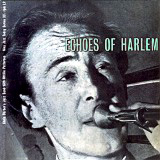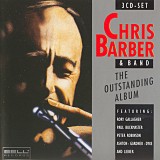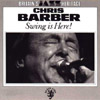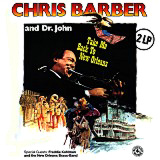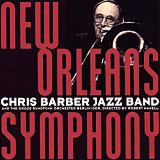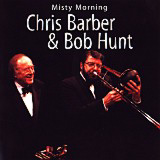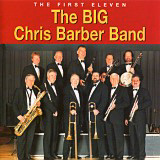|
Accolades for an English musician don't come more exotic than a description of Chris Barber as the "Bix Beiderbecke of British-style jazz": this, from the pen of musicologist David Boulton back in 1958. Not that this kind of plaudit about Barber is confined to the past, nor to the jazz world: for instance, UK Blues Guitarist of the Year, Stan Webb, told the BBC, "My first thing I heard about anything to do with British blues? I loved Chris Barber, and have done to this day. He actually has graced the stage with me at the Marquee many years ago." And staying in the world of blues, the recently published reference work Blues-Rock Explosion emphasises how "Chris Barber, Alexis Korner, Lonnie Donegan and Cyril Davies ... were the real founding fathers of what became the British 1960s blues-rock explosion."
Both of these quotes expose an obscured truth about Barber and his Jazz and Blues Band: namely, that without the man who in 2004 celebrates 50 years as a pro band leader, not only would British trad jazz have taken many more years to evolve, but also the British blues and rock scene would not have exploded in the way that it did. Which partly explains why a blues-rocker such as Stan Webb (founder of Chicken Shack) has such good and vivid memories of jamming with Chris at the legendary Marquee Club. Other bluesmen who have shared a stage with him include Muddy Waters, Louis Jordan, Big Bill Broonzy, Champion Jack Dupree, Jimmy Cotton, and Sonny Terry & Brownie McGhee.
The Marquee's legend, to anyone aged under sixty, is linked to the rise of bands such as the Who, Rolling Stones and Sex Pistols. But here lies another overlooked truth: the Marquee started out in 1958 as a jazz club in which Barber, as a founding director, pooled his music business experience alongside the Marquee's then new owner (and seasoned jazz promoter) Harold Pendleton. Pendleton (an accountant) and Barber (a trainee actuary) met, quite by chance, on Harold's very first day in London in 1948. As well as establishing the Marquee, in 1961 together they initiated the National Jazz & Blues Festival, which eventually grew into the Reading Rock Festival.
| |
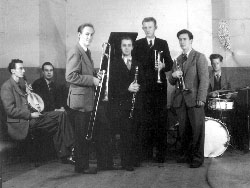 |
| One of Chris Barber's earliest bands |
Soon after meeting Pendleton Barber quit his job, choosing instead to study trombone and double-bass at the Guildhall School of Music. This was an astute choice of instruments for a trad jazz devotee because in the very earliest New Orleans jazz outfits such as the Original Dixieland Jazz Band the trombone was known as a "blown bass", its main function being to stress rhythmic accents.
Chris's fate had already been sealed when he bought a second-hand trombone from Harry Brown (of the Humphrey Lyttleton Band) at London's Leicester Square Jazz Club. Months later Barber formed his first band.
Another subtext to the 50th anniversary is that Barber has been around and making music for over half of the entire history of recorded jazz. His kind of jazz, he once explained to Philip Clark, is as follows: "The technical name for what we play is 'revived archaic jazz'. We have been accused of cleaning the music up, but we simply play it with right notes and chords." Maybe there is some modesty at work here because already back in 1958 David Boulton, for one, regarded Barber as more than just a revivalist or imitator of music from "the Crescent City." One reason why Boulton drew a comparison with Bix Beiderbecke was because he felt that in less than ten years as a band leader Barber's "imitation developed until it could exist in its own right. Whether or not this British style will eventually be considered of any permanent value is for a later generation to decide." Over forty years on, it looks like they have decided.
During the 1940s, the British jazz movement split into three: New Orleans revivalists such as pianist George Webb and trumpeter Humphrey Lyttleton (with Barber and Ken Colyer close behind); modern jazz players like Johnny Dankworth and Ronnie Scott, who took their lead from American bebop greats such as Charlie Parker and Dizzy Gillespie; and, thirdly, more of a cult following started off by trumpeter Freddie Randall, who was influenced by white Chicago-school jazzman Muggsy Spanier. Jazz caught on very fast in Britain during the late 1940s and early 1950s. Why ? Well, for a start its presentation live on stage was energetic and entertaining compared to 1940s dance bands, whose players were catatonic by comparison, being mostly sat down and hidden behind music stands. And one of many trad bands that emerged alongside Barber's then amateur outfits (called the New Orleans Jazz Band or Chris Barber's 'Washboard Wonders' when he was playing string bass) was the Crane River Jazz Band featuring clarinettist Monty Sunshine and trumpeter Ken Colyer. Along with banjo player Lonnie Donegan (plus Jim Bray on bass and tuba, and Ron Bowden on drums), these were the musicians who teamed up with Chris Barber in 1953.
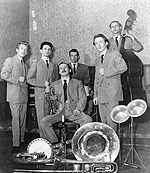 |
|
Ken Colyer's Jazzmen
1953-54 |
Chris now remembers taking the big step to go pro: "At the time Monty was leading the last remnants of the Crane River Jazz Band. His band, like my band, was playing once a week and the trouble with that is you never learn from the mistakes you make on stage because a week later you've forgotten you made them. So we thought, this is stupid: the only way to progress was to pool our resources and play the music professionally."
With Sunshine, Donegan, Bray and Bowden, the first Barber band was born, and its instrumentation did not feature either piano or trumpet, largely because they didn't know one of either who really shared their aim of becoming professional, but as Chris explains: "Without piano and trumpet, the rhythm section is more exposed and obviously this influences not only the band's sound but also the arrangements." So as band leader, Barber was drawn to material such as George Lewis's "Ice Cream" and records by the Mezz Mezzrow-Tommy Ladnier Quintet, as well as adapting standard material by King Oliver, Louis Armstrong, and Jelly Roll Morton.
| |
 |
| |
Chris Barber's Jazz Band, 1954 |
Nonetheless, early on a trumpeter was brought in. Twenty-three-year old Pat Halcox (still with Barber's band to this day) joined for a short spell before having to resume his studies. His departure came right around the time that Ken Colyer returned from his infamous seaman's holiday to New Orleans. Barber wrote to Colyer inviting him to join. (Ken's trip had earned him crowd-pulling kudos: he jumped ship from the merchant navy in New Orleans and there shared the stage with American legends such as George Lewis before visa problems got him banged up in jail and then deported.) Regular appearances at hot venues such as the Bryanston Street Jazz Club near Marble Arch soon gave this outfit a big following: they were known as Ken Colyer's Jazzmen.
But not for long. Within a year Colyer's drinking and volatile temperament brought tensions within the band to busting point; a bid by Ken to sack the rhythm section backfired (because the band was run as a co-operative) and instead it was the hapless trumpeter who found himself left out in the cold and without a gig. (Colyer soon formed a band that included future trad jazz pop star Acker Bilk).
Pat Halcox re-joined, this time for good, and the distinctive sound and musicianship of this, the original Chris Barber Jazz Band, is best heard on the 1955 album Echoes of Harlem (reissued on Lake LACD87). It opens with a rare Ellington composition and goes on to be a fascinating retrospective of the musical life of Harlem in the late 1920s and early 1930s.
It was this early version of the band that catapulted banjo and guitar player Lonnie Donegan to stardom as a solo artist: Donegan recorded his first version of 'Rock Island Line' with Chris's band as part of the first LP recording, New Orleans Joys, in July, 1954, a couple of years before it was released as a single in 1956 and then became the hit that augured the skiffle craze. Skiffle was mostly mocked by trad jazz purists, but this never deterred Barber from giving it a slot in his show. Donegan was replaced by Dickie Bishop on banjo. Vocalist Ottilie Patterson also proved to be a big asset to Barber's show, especially so her engaging duets performed with visiting American gospel blues diva, Sister Rosetta Tharpe, in the late 1950s.
In the early 1960s skiffle and trad jazz were eclipsed by the beat group boom, which skiffle had helped to bring about in the first place. Barber remained unshaken: his own BBC programme Trad Tavern kept up his profile and meant he played along with a wide range of guests such as Joe Harriot, Archie Semple, and Tony Coe. Ian Wheeler, who replaced Monty Sunshine, and electric guitarist John Slaughter updated Barber's sound.
The band continued to tour America and impress their counterparts in the home of jazz. By the 1970s, as jazz musicians such as Miles Davis enjoyed popularity amongst rock audiences, Chris too incorporated rock influences into his band's sound. Proof of this can be found on the three-CD set The Outstanding Album (Bell Records BLR 89 300). One track could have come from Miles Davis's canon and nevertheless sat comfortably alongside re-working of Barber Band favourites such as 'Ice Cream' and 'Jeep's Blues.'
It was also during the 1970s that Chris explored Balkan folk music with its lilting and asymmetrical rhythms, and in his composition 'Ubava Zabava' fused it with the blues. Other 1970s shows included tours with John Lewis and Trummy Young in Swing is Here (Black Lion CD BL5 17), as well as Russell Procope and Will Bill Davis. The magic of the resultant Echoes of Ellington tour is captured on two Timeless CDs.
Most notable during the 1980s was Barber's Take Me Back To New Orleans tour with Dr John, as well as a collaboration with the East German State Radio Concert Orchestra in Berlin that featured orchestrations of New Orleans classics (New Orleans Symphony: Timeless TTD 610). In 1995 Barber staged a skiffle reunion UK tour with Lonnie Donegan and Dickie Bishop as special guests, as well as several tours of the reunited 1954 band with Monty Sunshine and Lonnie Donegan.
Back in the 21st century, the three recent additions to the lineup (Bob Hunt on trombone, Mike "Magic" Henry on trumpet, and Tony Carter on reeds, also featuring the baritone sax for the first time ever in the Barber band) make up a big Chris Barber Band that still features Pat Halcox on trumpet, John Slaughter on guitar, and Vic Pitt on bass. Clarinettist John Defferary replaced Ian Wheeler in 1998; Paul Sealey plays banjo and guitar; and Colin Miller is on drums. John Crocker left in 2003 after thirty-five years with the band, being replaced by Trevor Whiting. Of course, band leader Chris Barber's trombone slides on, and traditional jazz remains central to his work. The reason, Barber explains, is the unselfishness of the music: "I think that there is simply more to Dixieland jazz than modern. The ensembles are very complex and you have to be listening completely unselfishly all the time."
Misty Morning (Timeless TTD 641), a CD featuring Chris Barber and members of Bob Hunt's Ellingtonians, a forerunner to the Big Chris Barber Band, was recorded in 2001 by the augmented band as they performed their touring presentation of Duke Ellington's music, of which Bob Hunt is an acknowledged expert. When Chris began incorporating the extra three musicians into parts of the band's normal varied repertoire, the results were so exciting that the band all felt there was no alternative to permanently becoming an 11-piece band. The first recording of Chris's new organisation, The First Eleven (Timeless TTD 650), recorded live in Birmingham at the end of the 2001 tour, is a product of their understanding of the unselfish nature of ensemble playing and contains many of the best pieces in the new repertoire as it began to develop within the expanded band.
The First Eleven was followed in November, 2003, by a new CD, Jubilee Stomp (Timeless TTD 654), recorded mainly in Jools Holland's London studio. The CD's title appropriately reflects the 50th anniversary tour of the continent and Britain (there are several sets of photographs from the tour on the photographs page). On this outstanding CD, a wonderful Ellington-based repertoire from the pen of arranger Bob Hunt is augmented by several other innovative tracks that take advantage of the rich variety of colours made possible by the seven-man front line. An added bonus of the CD is the inclusion of five additional Chris Barber-Ken Colyer-Monty Sunshine tracks recorded between 1952 and 1954 that were only recently discovered.
Barber's relaxed and infectious enthusiasm for the music is a constant. His desire to communicate the music he loves is palpable and he brings to it the highest level of musicianship.
* This is an edited version of an essay that first appeared in the original www.chrisbarber.net |






